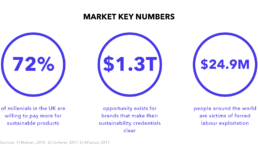In an increasingly globalised world, understanding supply chains in the food and retail sector can be difficult and lead to the unfair treatment of workers, who are invisible to consumers at the point of purchase. Increasing transparency via new technologies allows consumers, companies, and others to influence supply chain choices.
The increasing globalisation of the economy has led to complex, international supply chains in the food and retail sector, where aggregated multinational companies often sell products removed from their origin. It is estimated that 80% of global trade flows are controlled by multinationals. The road from raw material to final product is often blurry and opaque, making informed decision-making difficult. Improving product traceability and supply-chain transparency can deliver greater power to conscious consumers and responsible investors, as well as improving the ability of procurement departments to make informed decisions. Whether it is sustainable timber products or conflict-free diamonds, creating access to provenance data incentivises companies to operate more sustainably and to respect human rights along their supply chains.
Blockchain technology makes it possible to give products a digital passport from the point of origin, and then track that product as it travels through the supply chain. Every time a product changes hands, the transaction is documented on the blockchain, creating an immutable history from production to sale. It is possible to trace every product back to the origin of raw material used and who has been involved in the production using a distributed, decentralised, and tamper-proof database.

Products and Services
Services in this opportunity include improving certification processes, such as those provided by Provenance, which uses blockchain technology to digitally track products and prove fair trade.
Anything that can be digitised can be stored on the blockchain, which presents opportunities for more digital products that can further improve the certification process. Satellite systems can monitor deforestation and, when linked to smart contracts, pay communities to maintain forests. Artificial intelligence and the blockchain can integrate data from multiple sources, devices, and systems, and enable enterprises to optimise every aspect of their supply chains with respect to economic, environmental, and ethical criteria.

Market Size and Demand Drivers
Transparency pays off. For example, John West, a global producer of canned fish implemented codes enabling customers to trace tuna all the way back to the fisherman who caught it. This opening up of the supply chain netted the company more than $22 million in increased sales.
This increased demand for transparency and supply chain information is reflected in the growth of eco-labels too. Voluntary sustainability standards are no longer confined to niche markets. Sustainable agricultural products with internationally recognised standards are growing at a higher pace than conventional product markets, particularly in the cotton market, which saw the certified area grow by 250% between 2011 and 2015. Blockchain technology is expected to catalyse further growth in these markets over the next five to ten years, with some estimating CAGRs of more than 70% up to 2022.
While blockchain may have the capacity to improve the transparency of supply chains and reduce inequalities, a lot of electricity is currently required to process transactions. This is a challenge that needs to be addressed before the blockchain can scale sustainably.
This market featured in the 2018 Global Opportunity Report.

